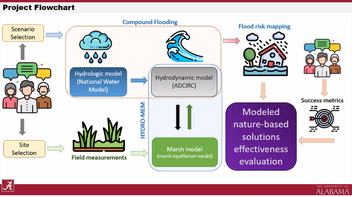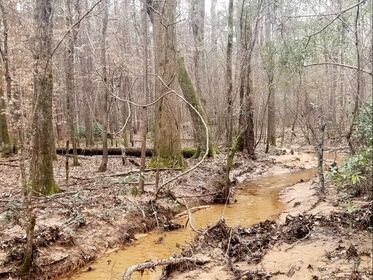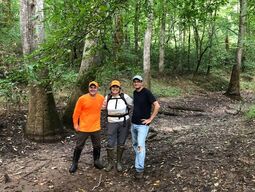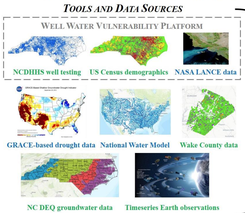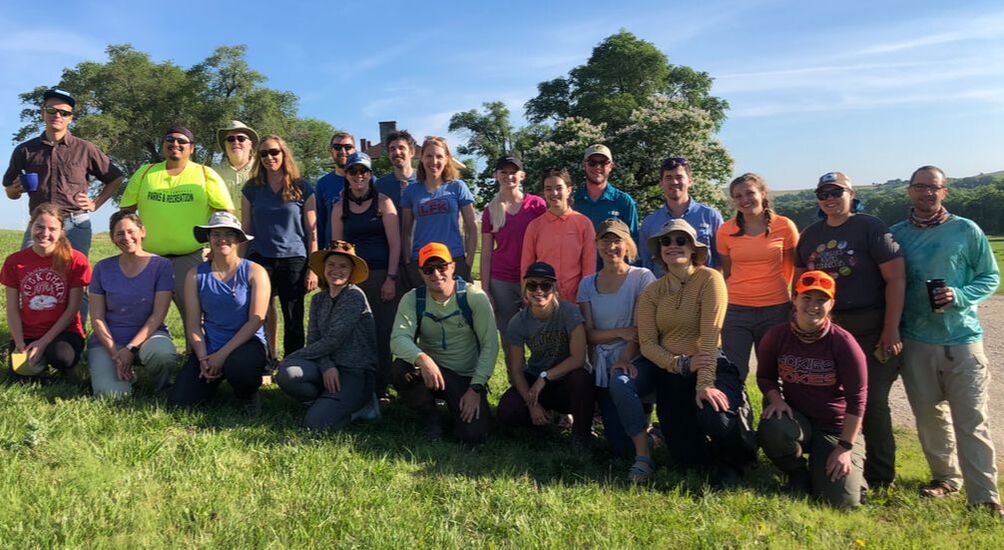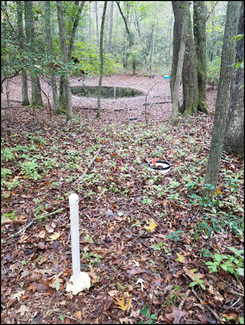Coastal nature based solutions to mitigate flood impacts and enhance resilience
|
Nature based solutions such as breakwaters (grey infrastructure) and marsh restoration (green infrastructure) are often employed in coastal environments to mitigate flooding and enhance infrastructure resilience. The sustainability of these systems depends on climatic, hydrologic, and oceanic conditions. Recent ecological-hydrodynamic coupled modeling development improved our understanding of the dynamic response of coastal wetlands to chronic processes (i.e., sea level rise; SLR). However, there remains a need for appropriate tools/platforms that: i) quantify the performance of wetland restoration projects as forms of NBS through integrated field, remote sensing, and modeling-based studies, and ii) translate the outputs of such dynamic modeling practices to actionable data and policy guidelines for decision makers and planners. In this study, our interdisciplinary team will work with community partners to address these challenges across Mobile Bay.
Collaborators include Drs. Hamed Moftakhari (UA), Julia Cherry (UA), Hamid Moradkhani (UA), Wanyun Shao (UA), and Renee Collini (The Water Institute). Funded by NOAA through the Cooperative Institute for Research to Operations in Hydrology |
The Floodpulse Project
|
Wetlands are critical “control points” for nutrient processing and retention, improving water quality in streams and rivers. In particular, wetlands are important for removing nitrogen (N), mitigating negative impacts such as eutrophication in downstream waters. Much of N processing in wetlands is carried out by microbes that live in the soil, whose activity is regulated in part by the availability and quality of organic matter (i.e., dead plant material) and oxygen. Flood disturbances affect both organic matter delivery and oxygen dynamics in wetlands, potentially altering N removal processes. However, we do not understand how hydrologic connectivity, that is, the mode through which wetlands receive and export water, affects organic matter delivery to floods or the subsequent effects on wetland N removal.
The objective of this study is to investigate wetland hydro-biogeochemical responses (specifically, N processing) to flood disturbances and the subsequent impacts on watershed nutrient export. We will use event-centered measurements at the wetland and watershed scales to integrate wetland and watershed models to advance our predictive capacity for assessing how flood disturbances impact watershed biogeochemical cycling and nutrient export. Collaborators include Behzad Mortazavi (UA), Corianne Tatariw (UA), Xingyuan Chen (PNNL), and James Stegen (PNNL) Funded by DOE-Environmental System Science Program (click here) |
Flood Impacts on Private Drinking Water Systems
|
An estimated 2.4 million North Carolinians (1 in 4 residents) are reliant on unregulated private wells for their drinking water supply. These residents do not have the same level of protection from drinking water hazards as those served by regulated municipal water, resulting in widespread, multifaceted well water contamination problems. Natural hazards likely magnify these disparities, as there are well-known inequities in hazard risks, infrastructure recovery, and social infrastructure rendering well populations more vulnerable and less resilient. Data availability and limitations are primary barriers hindering the accurate identification of private wells affected by natural disasters. We believe that integrating satellite observations from NASA’s Earth Science Data into drinking water disaster recovery platforms would more effectively account for well users affected by natural hazards. Our research goal is to create a spatially explicit North Carolina well water vulnerability platform that integrates NASA satellite observation data; drinking water supply and water quality data; demographic information; and self-reported water use behaviors data.
Collaborators include Kelsey Pieper and Ed Beighley Funded by: NASA Water Resources |
Aquatic Intermittency Effects on Microbiomes in Streams (AIMS)
|
Our understanding of physical, chemical, and biological drivers of water quality are based on perennially flowing waters. However, more than half of global stream-miles do not flow continuously. These intermittent streams occur across the entire country--from western deserts to eastern forests. Despite their ubiquity, research on intermittently flowing streams is impeded by a lack of: 1) physical infrastructure designed to measure intermittency, and 2) scientific training that straddles aquatic and terrestrial ecology. The Aquatic Intermittency effects on Microbiomes in Streams (AIMS) project will address these obstacles by creating a network of instrumenting sites from Alabama to Kansas and Idaho to study the hydrology, biogeochemistry, and microbiology of intermittent streams. Importantly, these sites will also connect our large collaborative network and enable us to address key gaps in our understanding of these important systems.
Funded by: NSF EPSCoR Track II (2019603) |
Hydrologic connectivity and water storage as drivers of carbon biogeochemistry in wetland-dominated catchments
|
Worldwide, low-lying areas once rich in forested wetlands have been converted to agricultural production after draining and filling. Prior to their loss, the wetlands reduced flooding through water storage, provided downstream environments with an important energy source in the form of dissolved organic carbon, and played a critical role in regional carbon budgets. This research will test how spatiotemporal changes in surface and subsurface hydrology govern carbon dynamics in wetland-rich landscapes. Using coupled empirical and modeling components, we will quantify: (1) dynamics of surface water connections and surface-subsurface exchange at wetland and catchment scales; and (2) consequent hydrologic influences on wetland- and catchment-scale carbon dynamics. The study sites are on the Delmarva Peninsula of Maryland. Our research will integrate hydrologic sciences, ecosystem ecology, biogeochemistry, and restoration science; and ultimately, help inform wetland restoration and land management across the coastal plain region.
Collaborators include DL McLaughlin, ER Hotchkiss, & DT Scott (Virginia Tech); MA Palmer (University of Maryland College Park). Funded by NSF-DEB (2019 - 2022) |

